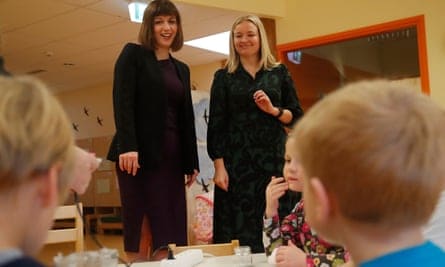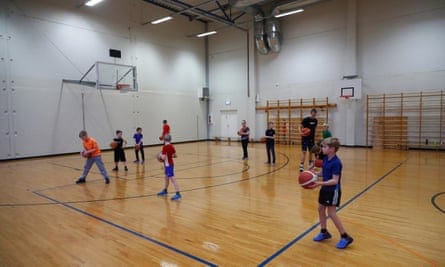[ad_1]
At 7am, in the dark of an autumnal Estonian morning, parents begin to arrive to drop off their children at the kindergarten in Viimsi, a 20-minute drive from the capital, Tallinn, before heading off to work in the city.
The day starts officially at 9am, but Laanelinnu kindergarten, one of eight in the MLA Viimsi family of nurseries, opens two hours earlier and does not close until 7pm, to provide maximum flexibility for parents and the demands of their work.
The kindergarten, built in 2012, is bright, airy and modern. Classrooms, with vast windows that look out on to surrounding forest fan out around a white-washed central hall, and outside a large playground wraps around the entire building.
Some of the children who attend Laanelinnu are as young as two, but as we enter the building barely a sound can be heard. In each of the classrooms, which are spacious and well-equipped, there are up to 20 children – attentive and focused – supervised by a qualified early years teacher and two assistant teachers.
In Estonia, early years teachers must have at least a first degree, while schoolteachers generally have a masters, meaning the education workforce is more highly qualified than in England. Assistant teachers, meanwhile, are offered training and development to improve their skills. There is no Ofsted equivalent, no school inspectors and teachers are allowed autonomy over the education they deliver.
Despite the visitors, the children at Laanelinnu remain engaged in their lessons. In one darkened classroom, they lie on their backs in a quiet corner as they and their teacher prepare for the day ahead. In another class, there’s music and dancing. In another group, children are doing a project about the human body, while next door there’s a cookery class going on, with a tasting session first followed by rye bread making.
The kindergarten caters for children aged two to seven, at which age it becomes compulsory to attend school. There’s a specialist music teacher, a PE teacher and, while children in England can wait months to get expert support, here there are in-house psychologists and speech therapists always on hand to help children who are struggling.
The early years curriculum takes in everything from letters and language skills, to art, music and robotics. “Though it’s not called school, it’s the first step in their education,” says Pille Veisserik, the kindergarten’s project manager. “We do teach kids here. It is not just childcare.” By the time they leave, most children will have learned to read and write, but in a relaxed, play-led environment.
Parents in this Baltic country, with its population of 1.3 million, also enjoy some of the best state support in the world. New mothers can take 140 days of fully paid leave, after which they can either take a further 435 days – again fully paid – or share it with a family member.

While parents in England face crippling childcare costs and patchy provision, in many cases forcing them to stop work, in Estonia a guaranteed place at kindergarten is available to all children between the ages of 18 months and seven – at minimal cost.
At Laanelinnu, families pay just €58 (£50) a month, plus extra for three hot meals a day. In England, full-time nursery for children under two can cost two-thirds of a parent’s weekly take-home pay or more.
The kindergarten system is an integrated part of Estonian education – there is very little private provision – and at the end of their time there, children are given a school readiness card that they take with them to the next stage in their education, to a school such as Tallinna Südalinna in the heart of Estonia’s capital city.
Südalinna is a põhikool or basic school, teaching children aged seven to 15. It also offers a long school day, with children able to stay on site until 5pm to enjoy “hobby school” – one of the 20-plus after-school “hobby groups” on offer that are nearly all free of charge. Not only does it help parents, it supports children’s learning and development. Early morning porridge and lunch are free, but you have to pay a nominal fee if you want a second lunch later in the day.
Privacy Notice: Newsletters may contain info about charities, online ads, and content funded by outside parties. For more information see our Privacy Policy. We use Google reCaptcha to protect our website and the Google Privacy Policy and Terms of Service apply.
When the shadow education secretary, Bridget Phillipson, visited on Tuesday evening, there was basketball club, a Halloween cinema night with popcorn and a robotics club, where pupils played with the sort of sophisticated equipment you might find in a university, including British-made VR headsets unlikely to be found in most British classrooms.
Robotics is big in Estonia, as is digital learning. The government has made them a priority and when the coronavirus pandemic struck, Estonian schools switched seamlessly to home education because children – and parents – were already used to learning online. The teachers at Südalinna have their own digital mentors to ensure they are kept up to speed with the latest innovations.

“Our society needs more and more people who are capable of using these things,” said Kerttu Mölder-Jevdokimov, the head of the elementary school. “We are such a small country we can’t make an impact in other ways, but in IT we can.”
Estonia’s schools are struggling with the same teacher recruitment crisis as schools in England, and there is a difficult transition under way to get Russian-speaking schools to adopt the Estonian language, as Vladimir Putin’s war in Ukraine continues to rage. But Estonia’s approach to education is having a positive effect on attainment.
It is now one of the highest performing countries the OECD’s Programme for International Student Assessment (Pisa) tests in mathematics, science and reading. By the same measure, it is top of the class in Europe and has been dubbed the “new Finland” after overtaking its neighbour, while the UK – despite showing signs of improvement in the 2018 round of tests – still lags behind mid-table.
The Pisa tests are only one measure, but as the Labour party realises, there are lessons to be learned from this tiny Baltic state.

